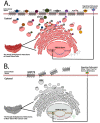Potential to Eradicate Cancer Stemness by Targeting Cell Surface GRP78
- PMID: 35883497
- PMCID: PMC9313351
- DOI: 10.3390/biom12070941
Potential to Eradicate Cancer Stemness by Targeting Cell Surface GRP78
Abstract
Cancer stemness is proposed to be the main cause of metastasis and tumor relapse after conventional therapy due to the main properties of cancer stem cells. These include unlimited self-renewal, the low percentage in a cell population, asymmetric/symmetric cell division, and the hypothetical different nature for absorbing external substances. As the mechanism of how cancer stemness is maintained remains unknown, further investigation into the basic features of cancer stemness is required. Many articles demonstrated that glucose-regulated protein 78 (GRP78) plays a key role in cancer stemness, suggesting that this molecule is feasible for targeting cancer stem cells. This review summarizes the history of finding cancer stem cells, as well as the functions of GRP78 in cancer stemness, for discussing the possibility of targeting GRP78 to eradicate cancer stemness.
Keywords: GRP78; cancer stem cells; cancer stemness; cell cycle; cell division.
Conflict of interest statement
The authors have no conflict of interest to declare.
Figures



Similar articles
-
The Endogenous GRP78 Interactome in Human Head and Neck Cancers: A Deterministic Role of Cell Surface GRP78 in Cancer Stemness.Sci Rep. 2018 Jan 11;8(1):536. doi: 10.1038/s41598-017-14604-5. Sci Rep. 2018. PMID: 29323121 Free PMC article.
-
Elimination of head and neck cancer initiating cells through targeting glucose regulated protein78 signaling.Mol Cancer. 2010 Oct 27;9:283. doi: 10.1186/1476-4598-9-283. Mol Cancer. 2010. PMID: 20979610 Free PMC article.
-
Betulinic Acid Inhibits the Stemness of Gastric Cancer Cells by Regulating the GRP78-TGF-β1 Signaling Pathway and Macrophage Polarization.Molecules. 2023 Feb 11;28(4):1725. doi: 10.3390/molecules28041725. Molecules. 2023. PMID: 36838713 Free PMC article.
-
Cancer cells stemness: A doorstep to targeted therapy.Biochim Biophys Acta Mol Basis Dis. 2020 Apr 1;1866(4):165424. doi: 10.1016/j.bbadis.2019.02.019. Epub 2019 Feb 26. Biochim Biophys Acta Mol Basis Dis. 2020. PMID: 30818002 Review.
-
Emerging Roles of DLK1 in the Stem Cell Niche and Cancer Stemness.J Histochem Cytochem. 2022 Jan;70(1):17-28. doi: 10.1369/00221554211048951. Epub 2021 Oct 4. J Histochem Cytochem. 2022. PMID: 34606325 Free PMC article. Review.
Cited by
-
Hsa_circRNA_001676 accelerates the proliferation, migration and stemness in colorectal cancer through regulating miR-556-3p/G3BP2 axis.Sci Rep. 2023 Oct 26;13(1):18353. doi: 10.1038/s41598-023-45164-6. Sci Rep. 2023. PMID: 37884630 Free PMC article.
-
Cancer stem cells and their role in metastasis.Cent European J Urol. 2025;78(1):40-51. doi: 10.5173/ceju.2024.0144. Epub 2024 Nov 28. Cent European J Urol. 2025. PMID: 40371432 Free PMC article. Review.
References
-
- World Health Organization Cancer. 2022. [(accessed on 3 February 2022)]. Available online: https://www.who.int/news-room/fact-sheets/detail/cancer.
Publication types
MeSH terms
Substances
LinkOut - more resources
Full Text Sources
Medical
Research Materials
Miscellaneous

